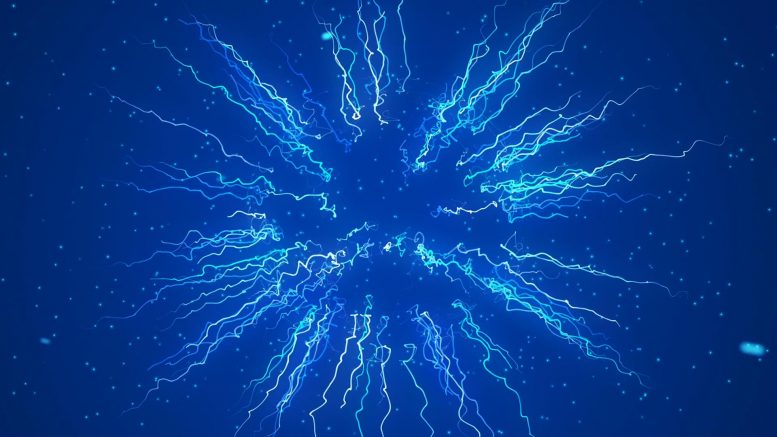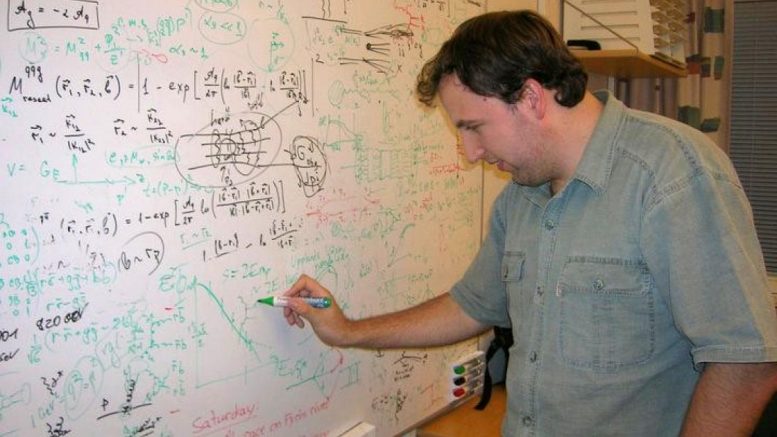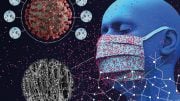
A research group has discovered the mythical particle Odderon through extensive analysis of experimental data.
For 50 years, the research community has been hunting unsuccessfully for the so-called Odderon particle. Now, a Swedish-Hungarian research group has discovered the mythical particle with the help of extensive analysis of experimental data from the Large Hadron Collider at CERN in Switzerland.
In 1973, two French particle physicists found that, according to their calculations, there was a previously unknown quasi-particle. The discovery sparked an international hunt.
The Odderon particle is what briefly forms when protons collide in high-energy collisions, and in some cases do not shatter, but bounce off one another and scatter. Protons are made up of quarks and gluons, that briefly form Odderon and Pomeron particles.
And now a research team, involving researchers from Lund University, has succeeded in identifying the Odderon in connection with an advanced data analysis study at the particle accelerator CERN.

Roman Pasechnik, particle physics researcher at Lund University. Credit: Gunnar Ingelman
”This is a particle physics milestone! It feels fantastic to contribute to an increased understanding of matter; the fundamental building blocks of our world,” says Roman Pasechnik, particle physics researcher at Lund University.
Through extensive data analyses of elastic proton-proton and proton-antiproton collisions, the researchers were able to hone in on the new particle. The analysis took several months, but finally paid off.
”We worked with some of the world’s best particle physicists. They were astonished when we published our results,” concludes Roman Pasechnik.
Reference: “Evidence of Odderon-exchange from scaling properties of elastic scattering at TeV energies” by T. Csörgő, T. Novák, R. Pasechnik, A. Ster and I. Szanyi, 23 February 2021, The European Physical Journal C.
DOI: 10.1140/epjc/s10052-021-08867-6









Odderon is the fundamental particle that does not splits by any hardest physical impact and lest ìnteraction with energy çonstituts pŕoton.
Odderon iss the fundamental particle uneffected by any physical force and lest interaction with energy constitutes protòn
Armchair physicist here; so, basically, they sifted thru a s#!tload of old data points and found a new particle?
If uneffected by any physical force maybe in the future we can create real force fields. Just a thought.
Strange: Can’t say I’ve ever heard of it.
Hmm
Mindchild: ” this was not discovered at the beginning when use of tides were created to clash two atoms and to split them?
Fake news
I’ve heard that when the particle accelerators smash particles together, the amount of data is far more (orders of magnitude) than we can process. The data exists and is recorded, but you really need to know what you’re looking for because it’s unfeasible to try to process it all at the time of the event.
Congratulations your education is officially a lie
Not fake news. What a completely vapid response
I have to say they were just looking in Odderon places… I’ll see myself out.
Nowadays you have phone antimatter with CERN and the hydrogen collider now we can make antimatter send it to space heaven and irate make a black hole and you annihilation create our own planet man has done that with just 1% of God in us
Major Peters. This article and anything written out in cyber-land is subject to scrutiny. I gotta tell ya though, I am more convinced by the words than I am with your “na ah” retort .
One commentator said he “had never heard of it”…Well, even Steven Weinberg, the greatest living physicist and Nobel Prize winner, hasn’t heard of it either! I’ve looked in his treatise The Quantum Theory of Fields, and couldn’t find any mention of it!! And here they’re saying physicists have been looking for it for 50 years. Amazing!
So, is the flux capacitor, that which makes time travel possible?
And just HOW will this “discovery” help address the problems here in the real world? (Hint: It won’t.) Great work guys…now get a job that actually contributes to our society.
I wonder !!!
Even still people don’t understand that there is no smallest particle it is like looking for a biggest particle which so atoms according to my theory is not the smallest particle (My theory known as the vise versa) just a theory soon to be a Law
Thank you all for your combined perseverance in pursuit for our humanity.
C Roget, particle physics is the most difficult path of study (next to quantum mechanics) of any college pathway by FAR. Im a physics major and particle/quantum theory is extremely intimidating when you see it mathematically.
Let’s leave the burger flipping to the burger flippers, and the big boy understanding of the universe to the scientists. Several of our everyday technological advances came from people of whom others were saying ‘great, now get a real job.’
Had I known they were looking for this, I could’ve told them where it was. I found it on my leg about 15 years ago. Looks just like it!!! 😁😁
Thank you, RYAN. I feel your ignominy, but certainly agree with the skepticism you embody. It IS a great time in physics however & every day brings new discoveries.
Early April Fools Day prank.
They had be looking in odderon places. Ha!
C Roget: I’m dying to know what it is that you do at your job. Are you a mindless piece of the machine? I am sure that your contributions to society are of such importance that the entire system would collapse without you, right? Why are you wasting your (our) precious time reading this nonsense??
Read most of the comments and I ask myself “what are most of these people doing on this page ?”.
This is the kind of advancement that will help all of humanity.
Um just wondering if this here particle discovery is gonna mean anything important? We got liberal riots and flag burnings and illegals pouring into the USA and freedoms are being eliminated daily with the deep state and you scientists are wasting billions of dollars colliding invisible nano particles, proving only that insanity is a real thing!
Have you ever seen the particles that power the mobile device in your hand? Or the ones that allow planes to fly or ships to float? So to answer your question, yes, the world does benefit from science every once in a while. The fact that Trump got his COVID vaccination the first chance that he got should tell you something. Live long and prosper, my friend!
Wrong Ricky, Religion proved insanity is a real thing.
These comments just show me the type of decadence as society we’ve descended into. It’s incredible how anti-intellectualism is alive and kicking.
Ok new particle blah blah blah so when’s the time machine gonna be done? El psy congroo
Is this possibly any step closer to finding the graviton? I want to travel throughout dimensions! Who knows what there could be out there?
🐲 )|\ (\
( (/__|_))
|/|/—–|/
This has to be fake news. Everyone knows Odderon was destroyed by the death star during the galactic civil war.
Come on Muleskinner, that’s a classic wookie mistake. Least they finally found the droids they were looking for…
To me it looks like an egg being fertilized by sperm.
I hope someone finds a way to beneficially apply this wisdom.
If you see Higgs tell em’ I found his freaking boson and I’m not giving it back
I agree will C Roget, why the hell arent…ALL OF OUR TOP SCIENTISTS no matter what field they specialize…WORKING ON PROBLEMS HERE ON EARTH.?
AND THEY SHOULD NOT BE MAKING ANY KIND OF HOLES…WITHER THEY BE BLACK…WORM…OR…PROTON!!!
DAMMIT….
If we keep progressing like this maybe one day we’ll have a full icle!
We glimpsed the whole world otherwise there was a complete universe at each spot/place/horizon created by The Almighty Lord of the universe… And we have to return unto him and be accountable to a slightest deed either good or bad we’ve done. All praises to Him who has no short-coming and who has created time and who has spread the universe, the life and death to see who emerges with the beautiful deeds…
Juliana Guinn they did work on that problem here on earth. They didn’t figure it out up in outer space.
Everything is relative from where you view it from….
The ‘why aren’t you doing anything for Earth, its burning’ Karens stfu and continue with your humanities studies. Science isn’t your cup of tea.